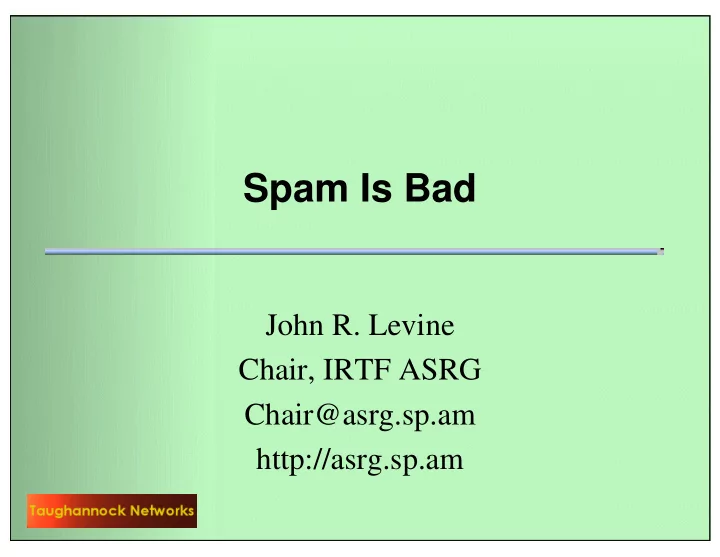

Spam Is Bad John R. Levine Chair, IRTF ASRG Chair@asrg.sp.am http://asrg.sp.am
Why is spam bad? • There’s too much of it • It’s offensive • It’s fraudulent 2
Why is spam bad? • There’s too much of it 98% – More spam than real mail everywhere 95% – Large ISPs see > 80% spam 90% – Even with filters, real 80% mail is lost in the noise 50% 0 10 20 30 40 50 3
Why is spam bad? • It’s offensive – Large amounts of porn – Porn in the spam itself – Who’d give their kid an e-mail account? 4
Why is spam bad? • It’s fraudulent – All those fake addresses – Forgeries of familiar addresses – Selling fraudulent stuff – Who’ll read real mail from the bank after getting 1000 fake mails from the bank? 5
What Isn’t the Spam Problem? • The Authentication Problem • The Introduction Problem • The Filtering Problem • The Accreditation Problem • The Reputation Problem 10
The Authentication Problem • Verify that a message is actually from the sender it purports to be from 11
The Authentication Problem • Verify that a message is actually from the sender it purports to be from 12
The Authentication Problem • Verify that a message is actually from the sender it purports to be from • Same person as last time? 13
The Authentication Problem • Verify that a message is actually from the sender it purports to be from • Same person as last time? • An actual real-life person? 14
The Authentication Problem • Verify that a message is actually from the sender it purports to be from • Same person as last time? • An actual real-life person? • An entity against which we can retaliate? 15
The Introduction Problem • Mail from hitherto unknown senders • Make it hard enough to deter spammers • But easy enough to admit real mail 16
The Introduction Problem • Mail from hitherto unknown senders • Make it hard enough to deter spammers • But easy enough to admit real mail E-postage Hashcash CAPTCHA Challenge/Response 17
The Filtering Problem • Distinguish nice mail from nasty mail • Try not to lose too much nice mail • Hope it’s not too expensive to do • Hope my tastes and yours aren’t too different 18
The Accreditation Problem • Third parties that vouch for potential correspondents • You can prove you’re nice to one place rather than millions? 19
The Accreditation Problem • Third parties that vouch for potential correspondents • You can prove you’re nice to one place rather than millions? – Bonded Sender – Habeas – IADB (ISIPP Accreditation Database) 20
The Reputation Problem • Who’s nasty, who’s nice • State of the art: DNSBLs • Needs a lot of work – What do you ask a reputation system? – What kinds of answers can they return 21
Are These the Spam Problem? • NO • They’re related to it • But they’re not the spam problem • Or even necessarily parts of it 22
What has ASRG done lately? • Reorganized into subgroups • One finished, a few under way 23
Lightweight MTA Authentication Protocol • Threw it over the wall to MARID • Reborn as SMTP authorization – Looking at analysis of effect of whatever MARID does 24
Abuse reporting • Simple convention for exchanging spam reports as e-mail • Large ISPs express interest 25
BCP • Drafted a few – DNSBLs / DNSWLs – Port 25 blocking and SUBMIT 26
Filtering • Some work on a header to document what filtering has happened • Now looking at filtering rule exchange 27
Message verification • Domain keys, Authenticated Mail, TEOS, Lumos, S/MIME, … • Look for common aspects – Probably redundant with MASS 28
Identity, Authentication, and Reputation • Lots of interest, no action • Sender-ID et al need a reputation system • How do we build them? What are the questions? What are the answers? • Can we invent common interfaces? 29
Things we’re not doing • Define spam • Challenge/response • E-postage • Replacements for SMTP 30
What’s happening elsewhere • Open Group – Validation profiles • MAAWG – Implementation advice to members • ITU-T – Technical and administrative coordination – Tell governments what to endorse 32
The standards process IETF ITU-T • Practical orientation • Driven by politics • Based on working • Paper designs prototypes • Slow cumbersome • Fast efficient process process 33
The standards process ITU-T IETF • Practical orientation • Driven by politics • Based on working • Paper designs prototypes • Slow cumbersome • Fast efficient process process 34
So where are we? • Spam is still bad • Solutions are hard • But we can make incremental progress 35
Spam Is Bad John R. Levine Chair, IRTF ASRG Chair@asrg.sp.am
Recommend
More recommend